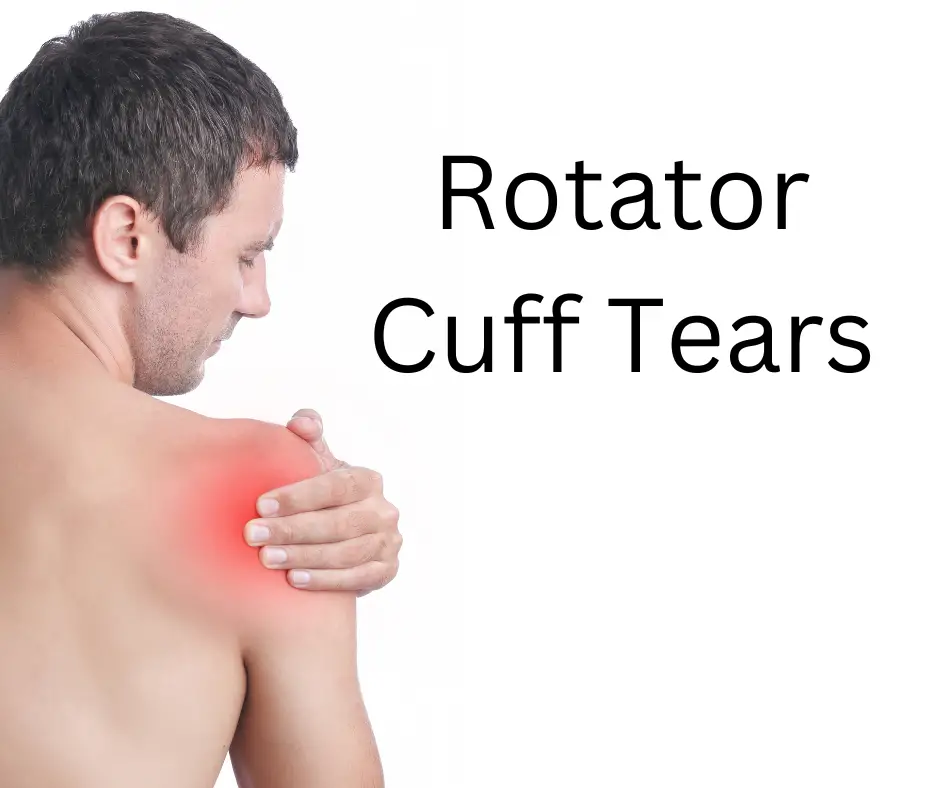Rotator cuff tears are common tissue changes that happen in the shoulder. There are four different RTC muscles that can be torn. Sometimes they cause symptoms and functional deficits and other times they do not.
Some people can lift their arm with no problem with a rotator cuff tear while others cannot. If you cannot lift your arm at all and all movement makes it worse you may require a surgical procedure however you should always consult a physical therapist before making that decision.
If you’re wondering about what happens if a rotator cuff tear goes untreated, I also wrote this article you might be interested in. (i’ll link to it once it’s finished)
Also, if you’re curious what RTC tears, degenerative disc disease, and meniscal tears have in common, give that article a read I just linked, to.

What exercises should you avoid with a torn rotator cuff?
Exercises to avoid with a torn RTC are any exercises that create significantly more pain and discomfort during and after exercise.
The type of exercise that causes symptoms will be different for each person so you’ll need to test out and see which ones feel okay and which ones do not.
Sometimes you don’t even need to change the exercise you might just need to decrease the weight, adjust your form, or decrease your range of motion.
Should I exercise my shoulder if my rotator cuff is torn?
There is no restriction with lifting if you have a torn rotator cuff. But, as I shared above, you’ll want to make sure that whatever exercise you are doing, isn’t causing additional discomfort.
What about if my shoulder hurts from the rotator cuff tear, is it still okay to exercise?
Same as above, if your shoulder hurts, modify your workout routine and adjust how much weight you’re using until your symptoms reduce or go away.
I always advise people to seek out the evaluation of a physical therapist to help them develop a program that doesn’t flare things up.
What are the best exercises to do if I have a torn rotator cuff tear?
Below, I’ll share a couple of great exercises to help you self-treat your shoulder and strengthen it.
Make sure you use lightweight to start with on each of these and only progress as your symptoms allow you to.
If most movements cause symptoms I would test one exercise a day and see which one feels best and build a program based on that.
Try doing 3 sets of 10 when you practice these.
Shoulder press
Lateral raises
Bent over rows
Bicep curls
Tricep pushdown
Reverse flyes
Key Takeaways
- Depending on the person, you should still be able to lift your arm after a rotator cuff tear.
- Many people have rotator cuff tears and don’t even know it
- As we get older, it’s more common to have an asymptomatic rotator cuff tear.
- Exercise is a great way to strengthen the shoulder and reduce symptoms

I am a part time drummer and I had a rotor cuff tear that could not be repaired. Fortunately, it was my left shoulder nd not my right shoulder. It was painful in the beginning and I took physical therapy for six months. My question is I am now able to raise my left hand straight into the air without any discomfort 99% of the time. Are there more than one tendon in your shoulder that enables you to be able to raise your arm straight into the air? I was told my tenson retracted back into my shoulder.
That’s great you can raise it straight into the air without pain most of the time. Great question!
Yes, you have many different muscles that attach via tendons around your shoulder joint that allow for stability and strength. The rotator cuff is composed of four muscles, teres minor, supraspinatus, subscapularis, and infraspinatus. Those are the primary muscles that provide added stability to the joint.
Additionally, you have your deltoid, lats, pectoralis major and minor, long and short head of the bicep tendon. All of these help to move the shoulder in various directions and provide added stability, too.
So, as you can see, plenty of structures to compensate for one or even multiple tears.